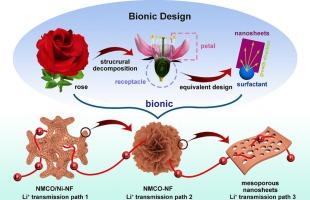仿生玫瑰三维多尺度层次化纳米花设计:介孔Ni-Mn-Co-O阳极及其衍生品LiNi1/3Co1/3Mn1/3O2阴极促进高性能锂离子电池
IF 4.1
3区 化学
Q1 CHEMISTRY, ANALYTICAL
引用次数: 0
摘要
利用仿生技术构建复杂的微纳形貌是提高电极材料电化学性能的有效策略。首先,我们介绍了三维Ni-Mn-Co-O纳米花(NMCO-NF)作为锂离子电池转换负极材料的仿生设计、制备工艺和电化学性能。在此基础上,利用Ni泡沫支撑的NMCO- nf (NMCO/Ni- nf)构建了集成电极。得益于层次化结构设计,NMCO/Ni-NF不仅能有效缓解锂离子(Li+)在循环过程中的大体积变化,而且为锂离子(Li+)的传输提供了三种尺度路径,使其具有优异的电化学性能,在1 A g−1下循环150次后,平均充电容量为1052 mAh g−1,容量保持率为76.42%。同时,利用Python程序模拟了简单玫瑰结构在集流器上的二维动态生长过程,可视化了NMCO-NF在水热反应中的微纳结构演化过程。最后,以三维NMCO-NF为牺牲模板,成功合成了介孔LiNi1/3Co1/3Mn1/3O2纳米花(lnmco - nf)。通过实验验证了在三元阴极体系中构建复杂多尺度结构的可行性。本文章由计算机程序翻译,如有差异,请以英文原文为准。

3D multi-scale hierarchical nanoflower design of bionic rose: Mesoporous Ni-Mn-Co-O anode and its derivative LiNi1/3Co1/3Mn1/3O2 cathode boosting high-property Lithium-ion batteries
Constructing complex micro-nano morphologies via bionic technology is an effective strategy to enhance the electrochemical properties of electrode materials. Firstly, we present the bionic design, preparation processes, and electrochemical properties of 3D Ni-Mn-Co-O nanoflowers (NMCO-NF) as a conversion anode material for lithium-ion batteries. Furthermore, an integrated electrode is constructed using NMCO-NF supported by Ni foam (NMCO/Ni-NF). Benefited from the hierarchical structure design, the NMCO/Ni-NF can not only effectively alleviate the large volume changes during cycling but also provide three scale paths for lithium-ion (Li+) transmission, which makes it exhibit excellent electrochemical properties, that is, 1052 mAh g−1 in an average charge capacity and 76.42 % in capacity retention ratio after 150 cycles at 1 A g−1. Meanwhile, the 2D dynamic growth process of a simple rose structure on a current collector is simulated by a Python program, and the micro-nano structure evolution process of NMCO-NF in the hydrothermal reaction is visualized. Finally, mesoporous LiNi1/3Co1/3Mn1/3O2 nanoflowers (LNCMO-NF) are successfully synthesized by taking 3D NMCO-NF as a sacrificial template. The feasibility of constructing complex multi-scale structures in a ternary cathode system is verified by experimental means.
求助全文
通过发布文献求助,成功后即可免费获取论文全文。
去求助
来源期刊
CiteScore
7.80
自引率
6.70%
发文量
912
审稿时长
2.4 months
期刊介绍:
The Journal of Electroanalytical Chemistry is the foremost international journal devoted to the interdisciplinary subject of electrochemistry in all its aspects, theoretical as well as applied.
Electrochemistry is a wide ranging area that is in a state of continuous evolution. Rather than compiling a long list of topics covered by the Journal, the editors would like to draw particular attention to the key issues of novelty, topicality and quality. Papers should present new and interesting electrochemical science in a way that is accessible to the reader. The presentation and discussion should be at a level that is consistent with the international status of the Journal. Reports describing the application of well-established techniques to problems that are essentially technical will not be accepted. Similarly, papers that report observations but fail to provide adequate interpretation will be rejected by the Editors. Papers dealing with technical electrochemistry should be submitted to other specialist journals unless the authors can show that their work provides substantially new insights into electrochemical processes.

 求助内容:
求助内容: 应助结果提醒方式:
应助结果提醒方式:


